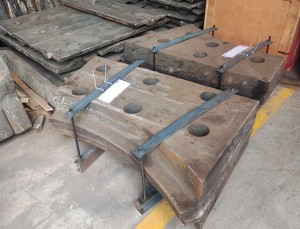Amid the continuous roar of the crusher, the liner, like a silent guardian, withstands the repeated impact of the materials with its body. When hard ores, metal scraps or construction waste are rambling around in the crushing chamber, it is precisely this special “armor” that protects the core structure of the equipment from damage. How to select the appropriate liner and extend its service life has become the key to ensuring the stable operation of equipment.
First, the three major defense mechanisms of the liner
High-quality liners provide protection in three ways:
Head-on resistance: Utilizing high-hardness materials to directly counter the impact of materials, the surface forms fine pits to absorb energy, much like the Kevlar fiber layer in a bulletproof vest.
Resilient buffering: Some of the liners are designed as resilient structures, which disperse impact forces through minor deformations, similar to the energy absorption principle of car bumpers.
Ingenious force relief: Liners with wavy or stepped surfaces can change the direction of material movement, converting linear impact into oblique sliding.
On-site case: A metal recycling plant found that after replacing the liner plate with a 45-degree beveled pattern, its service life was extended by 40%, as most of the metal fragments slid away along the pattern rather than colliding vertically upon impact.

Second, understand the language of wear and tear marks
The wear pattern of the liner will “tell” us a lot of information:
Uniform mist-like wear: Normal loss. Just record the thickness change
Furrow-shaped scratches: Indicate that high-hardness impurities have been mixed into the material
Shell-like peeling at the edge: This indicates that the fixing bolts have become loose
Radial cracks: Warning of material fatigue or excessive thermal stress
Practical tip: Draw grid lines on the surface of the backing plate with chalk. After running for 8 hours, observe the degree to which the lines disappear. This can visually assess the wear rate.
Third, five life-and-death details during installation
Clean the contact surface: Use a wire brush to thoroughly remove the residues of the old liners on the crusher shell. Even a 0.5mm bump will affect the stress distribution.
Freezing installation method: Freeze the new liner plate in an environment of -20℃ for 2 hours. Utilize the principle of thermal expansion and contraction to obtain an installation gap compensation of 0.3-0.5mm.
Torque stepwise tightening: Tighten the bolts in three increments in the diagonal sequence. The final torque needs to be verified with a calibrated wrench.
Gap filling: Apply special thermal conductive putty between the liner and the shell, which not only fills the microscopic gaps but also improves heat conduction.
Trial operation inspection: After running no-load for 30 minutes, tighten the bolts again. At this point, all components have completed the initial running-in.
Fourth, on-site wisdom for extending lifespan
Material pretreatment: Install magnetic separators and screens at the feed inlet to reduce the impact of metal impurities
Temperature monitoring: Regularly scan the surface of the liner plate with an infrared thermometer. If the temperature exceeds 150℃, the cause should be investigated
Regular adjustment: Rotate the liner by 180 degrees every 200 hours of operation to alternately apply force to the worn areas
Repair window: When the wear reaches 30% of the original thickness, it can be repaired by surfacing with wear-resistant welding rods
The experience shared by a certain cement factory: They applied molybdenum disulfide lubricating paste around the bolt holes of the liner plate, which not only prevented rust and seizing but also reduced the disassembly and assembly time by 60%.

Fifth, the golden rule for changing the timing
It is suggested to establish a three-dimensional evaluation system:
Thickness index: When the remaining thickness of most liners is less than 50% of the original design, they should be replaced
Performance indicators: Evaluation is required when the crushing efficiency drops by 15% or energy consumption increases by 20%
Safety indicators: If a penetrating crack occurs or the fixed structure fails, the machine must be stopped immediately
Maintenance personnel often say, “Replace the liner not when it is completely damaged, but when it is about to affect the overall health of the equipment.” To grasp the best replacement time, it is necessary to keep regular inspection records and draw the wear trend curve.
Post time: Aug-19-2025
